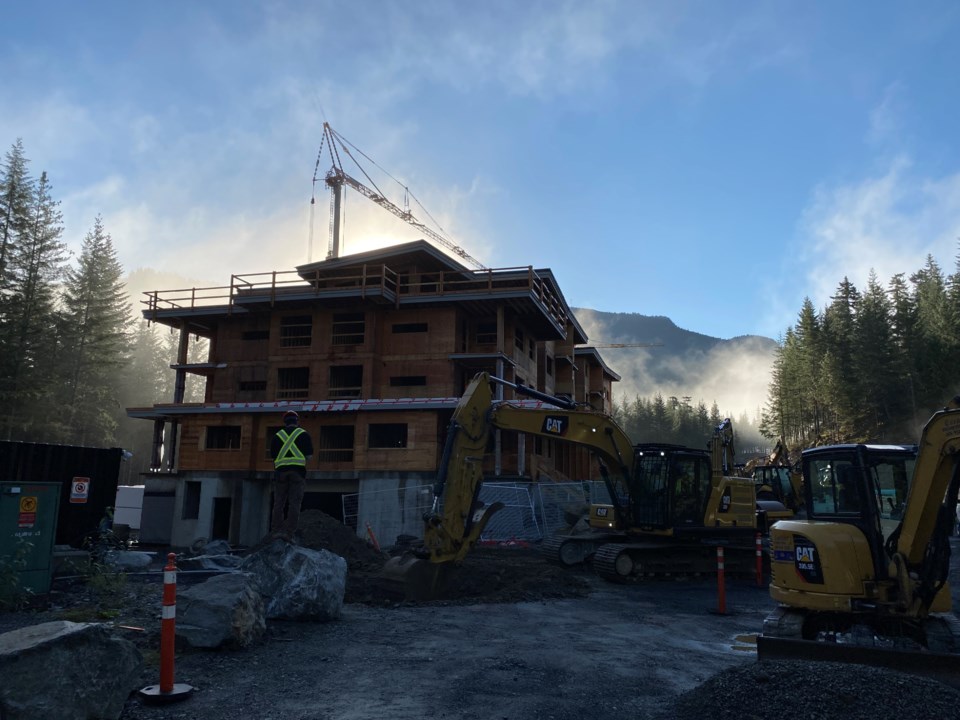A little more than four years after it set a target of adding 1,000 new resident-restricted beds in five years, the Resort Municipality of Whistler (RMOW) is closing in on its goal.
There are six active affordable employee housing projects in various stages of development at municipal hall, representing a potential 633 new bed units, said director of planning Mike Kirkegaard in a presentation to Whistler’s Committee of the Whole on Nov. 2.
“In addition to 386 employee beds that have already been constructed in that timeframe, we have the potential to achieve that target of 1,000 additional employee beds,” Kirkegaard said. “There’s been a tremendous amount of time and energy and resources put into these projects by the community—by staff and council and applicants—and I think a number of them are on the cusp of coming forward to council.”
The projects include: 2077 Garibaldi Way (14 employee townhouses and six market townhouses for ownership); 7104 Nancy Greene Drive (about 38 apartment units for rental); 4802-4814 Glacier Lane (66 two-bedroom dorm units for rental); 5298 Alta Lake Road (21 employee townhouses, 11 market tourist accommodation townhouses and 11 market residential townhouses for ownership); and 2028 Rob Boyd Way (13 employee one-bedroom dorm-style units for rental). There’s also the RMOW and Whistler 2020 Development Corporation’s 100 apartment units under construction in Cheakamus Crossing.
The 1,000-bed target arose from the Mayor’s Task Force on Resident Housing, launched by former Mayor Nancy Wilhelm-Morden in October 2016.
“We’re feeling cautiously optimistic that we’re making good progress,” said general manager of resort experience Jessie Gresley-Jones. “We’re definitely not going to say the job is in hand, and we can step back and relax, but I think we are getting to a point that we’re seeing positive uptake in the private employee housing initiatives, and we’re starting to really work towards that 1,000 bed units.”
Another recommendation of the task force was to tighten up eligibility requirements at the Whistler Housing Authority (WHA), which the RMOW did via an updated Employee Housing Council Policy adopted in July 2019.
The new policy defined eligibility and qualification requirements for accessing the WHA’s rental inventory, including defining an eligible employee as one who works a minimum of 30 hours per week in the resort (up from 20 hours/week), tightening the definitions around what constitutes a Whistler business, and requiring applicants to report their financial situation, including income and net assets, prior to offer of a tenancy agreement.
With the new housing projects coming online in the coming years, the RMOW is seeking to update its template for housing agreements related to all new projects, Kirkegaard said, adding that the goal is to have a standard approach that provides both certainty for owners and flexibility to evolving policies. As such, the 2019 changes brought in for rental units will now apply to ownership as well.
“Nothing is changing in that regard on the rental side. It’s been working for the last two years, but on the ownership side we’re looking to just align the two programs,” said WHA general manager Marla Zucht, adding that the WHA and RMOW have been in regular consultation with the community to determine what works and what doesn’t.
“We’ve had the benefit of having a lot of input from bringing on the WHA’s four new recent purpose-built rental projects, so we’ve been going through income and asset verifications for approximately 150 employee waitlist applications,” Zucht said.
“Whenever those units turn over, we are testing the eligibility again for the tenants, and we’ve also started creating some focus groups ... to get their input and feedback into some of these changes.”
Looking ahead, the WHA and RMOW may look to make some “small tweaks” to the policies around income and asset eligibility, “but that may not get picked up for another year or so, it just depends on how long that engagement process takes place,” she added.
The WHA’s purchase waitlist has about 850 names on it, while the rental waitlist sits at 350 (down significantly from the 1,200-plus on the list last February).
Anyone with questions about their eligibility can contact the WHA or find more info at whistlerhousing.ca.
The WHA doesn’t yet have information about when the new purchase product will be made available to the waitlist, but “we’re all excited about it … it’s great news for the community,” Zucht said. “We’ve brought on a lot of new rental inventory in the last four or five years, and it’s exciting now ... that new ownership housing on the horizon.”





